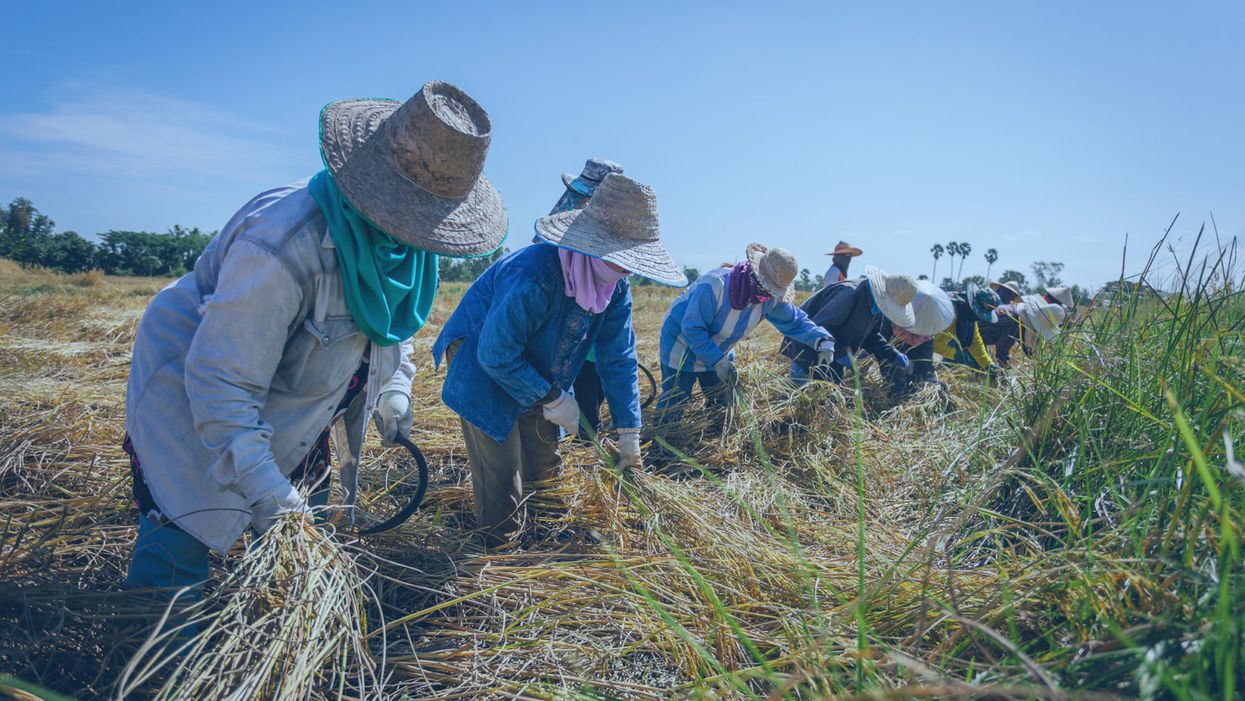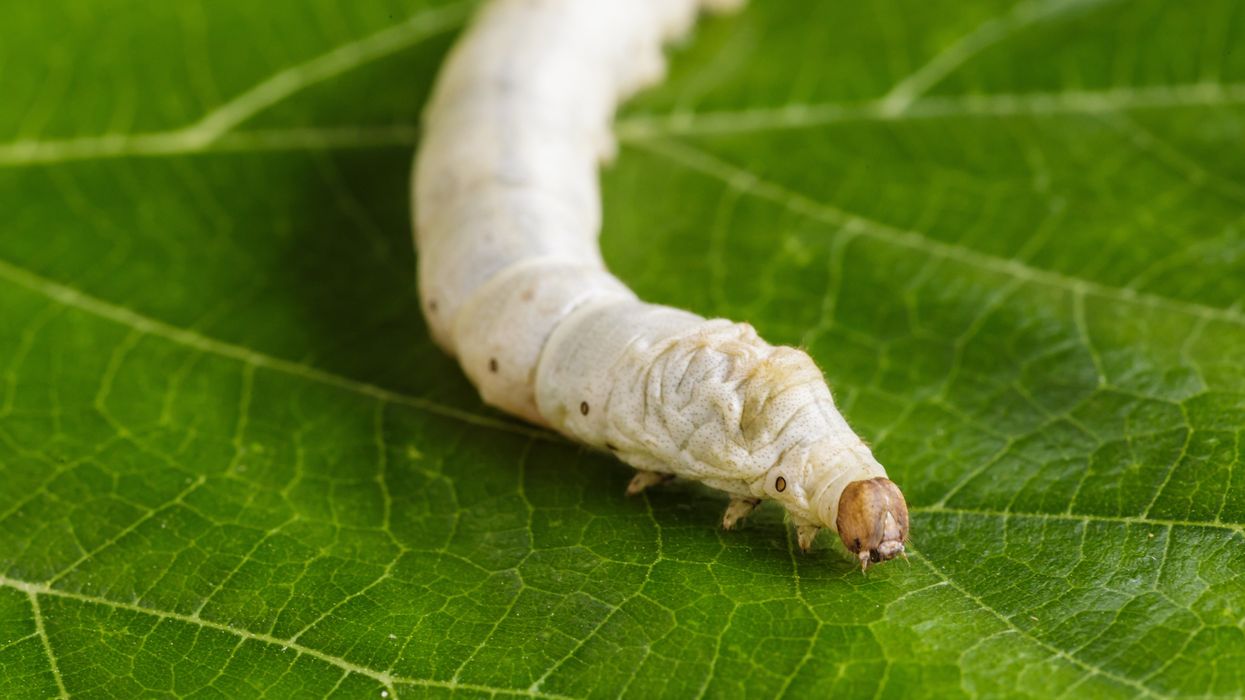Worried About Eating GMOs? That’s Not the Real Problem

Farmers harvest rice in a field.
The 21st century food system is awash in ethical issues. To name just a handful: There's the environmental impacts of farming, the human health effects of diets based on animal products and processed foods, the growing clamor around food waste, and the longstanding concerns about agricultural labor. The last decade has seen the emergence of "ethical consumption," as people have been encouraged to avoid products that are associated with animal cruelty or unfair to farmers.
Misguided concerns about GMOs are missing the point altogether and distracting from a far more substantive ethical problem.
But consumers have never been so ignorant about where food comes from, and they are vulnerable to oversimplifications and faulty messaging. Many would include the first generation of crops from agricultural applications of recombinant DNA methods for genetic improvement—so called GMOs—among the foods they should avoid for ethical reasons. Unfortunately, these misguided concerns are missing the point altogether and distracting from a far more substantive ethical problem.
As we stand on the precipice of a new era in food and biotechnology – crops and animals with genomes altered through gene editing – it is more important than ever to let go of unnecessary fears and to pay attention to the real hazards of agricultural innovation.
But first, as a bioethicist with almost 40 years of experience working on issues in the food system, let me stress the overall context and rationale for trying to make changes in plant and animal genetics. Doing so, whether through conventional breeding or biotechnology, allows producers to meet the challenges of seasonal climate differences and increase yields.
And just because a food was created through ordinary plant breeding vs. genetic modification does not automatically make it safe. Things can and do go wrong in ordinary plant breeding, such as with potatoes and tomatoes. These both produce toxins in the green parts of the plant, and breeders exercise caution to ensure that toxins aren't transferred to edible parts.
Despite real risks, there is no regulatory oversight that protects us from these known hazards. We rely on the professional ethics of agricultural scientists. And GMOs are, in comparison, much more carefully tested and regulated. The claim that they are "unregulated" is just false.
We should not ignore the role that all gene technologies have played in displacing small farmers, depleting rural communities, and shifting economic control.
I do want to shift the public's attention away from the anti-GMO debate to more substantive questions about contemporary agriculture that really have little to do with where the genes in their food came from, or how they got there.
No matter how important genetic improvements might be in terms of total global food production, we should not ignore the role that all gene technologies—including breeding—have played in displacing small farmers, depleting rural communities and shifting economic control of agriculture into a small circle of powerful actors. Globally, these changes have had disproportionately harmful effects on women and people of color.
Combined with mechanization and chemicals, gene technologies have freed planters from their dependence on impoverished and poorly educated field hands, but they did nothing to help the fieldworkers transition to a new line of work. These are the real problems that deserve the public's and the science community's attention, not the overly narrow worries about eating GMOs.
But these problems are viewed as "not ours" by agricultural insiders, and they continue to be ignored by scientists whose focus is solely on biology. Many of the concerns that are today viewed as "urban problems" or "social issues" have origins in agriculture. For example, in California tomatoes, the development of mechanical harvesting led to a rapid concentration of ownership and the displacement of thousands of field hands. In the South, similar technologies displaced black farmers working land owned by whites, causing migration to urban centers and unskilled jobs. I must fault the science community for a lack of willingness to even take the thrust of these more socially oriented critiques seriously.
The new suite of tools for genetic modification that go under the name "gene editing" promise greater precision. They should allow scientists to target the locus for new genes in a plant or animal genome, and minimize the chance for causing unwanted impacts on gene functioning. This added precision is reducing some of the uncertainties in the mind of technology developers, and they have been expressing hope that their own confidence will be shared by regulators and by the public at large. In fact, the U.S. government recently issued a statement that gene-edited crops do not require additional regulation because they're just as safe as crops produced through conventional breeding.
It is indeed possible that the public doubts about genetically modified food will be assuaged by this argument. We can only wait and see. Whether or not gene editing will lead to more reflection about agriculture's complicity in problems of economic inequality or structural racism depends much more on the culture of the science community than it does on the technology itself.
Fast for Longevity, with Less Hunger, with Dr. Valter Longo
Valter Longo, a biogerontologist at USC, and centenarian Rocco Longo (no relation) appear together in Italy in 2021. The elder Longo is from a part of Italy where people have fasted regularly and are enjoying long lifespans.
You’ve probably heard about intermittent fasting, where you don’t eat for about 16 hours each day and limit the window where you’re taking in food to the remaining eight hours.
But there’s another type of fasting, called a fasting-mimicking diet, with studies pointing to important benefits. For today’s podcast episode, I chatted with Dr. Valter Longo, a biogerontologist at the University of Southern California, about all kinds of fasting, and particularly the fasting-mimicking diet, which minimizes hunger as much as possible. Going without food for a period of time is an example of good stress: challenges that work at the cellular level to boost health and longevity.
Listen on Apple | Listen on Spotify | Listen on Stitcher | Listen on Amazon | Listen on Google
If you’ve ever spent more than a few minutes looking into fasting, you’ve almost certainly come upon Dr. Longo's name. He is the author of the bestselling book, The Longevity Diet, and the best known researcher of fasting-mimicking diets.
With intermittent fasting, your body might begin to switch up its fuel type. It's usually running on carbs you get from food, which gets turned into glucose, but without food, your liver starts making something called ketones, which are molecules that may benefit the body in a number of ways.
With the fasting-mimicking diet, you go for several days eating only types of food that, in a way, keep themselves secret from your body. So at the level of your cells, the body still thinks that it’s fasting. This is the best of both worlds – you’re not completely starving because you do take in some food, and you’re getting the boosts to health that come with letting a fast run longer than intermittent fasting. In this episode, Dr. Longo talks about the growing number of studies showing why this could be very advantageous for health, as long as you undertake the diet no more than a few times per year.
Dr. Longo is the director of the Longevity Institute at USC’s Leonard Davis School of Gerontology, and the director of the Longevity and Cancer program at the IFOM Institute of Molecular Oncology in Milan. In addition, he's the founder and president of the Create Cures Foundation in L.A., which focuses on nutrition for the prevention and treatment of major chronic illnesses. In 2016, he received the Glenn Award for Research on Aging for the discovery of genes and dietary interventions that regulate aging and prevent diseases. Dr. Longo received his PhD in biochemistry from UCLA and completed his postdoc in the neurobiology of aging and Alzheimer’s at USC.
Show links:
Create Cures Foundation, founded by Dr. Longo: www.createcures.org
Dr. Longo's Facebook: https://www.facebook.com/profvalterlongo/
Dr. Longo's Instagram: https://www.instagram.com/prof_valterlongo/
Dr. Longo's book: The Longevity Diet
The USC Longevity Institute: https://gero.usc.edu/longevity-institute/
Dr. Longo's research on nutrition, longevity and disease: https://pubmed.ncbi.nlm.nih.gov/35487190/
Dr. Longo's research on fasting mimicking diet and cancer: https://pubmed.ncbi.nlm.nih.gov/34707136/
Full list of Dr. Longo's studies: https://pubmed.ncbi.nlm.nih.gov/?term=Longo%2C+Valter%5BAuthor%5D&sort=date
Research on MCT oil and Alzheimer's: https://alz-journals.onlinelibrary.wiley.com/doi/f...
Keto Mojo device for measuring ketones
Silkworms with spider DNA spin silk stronger than Kevlar
Silkworm silk is fragile, which limits its uses, but a few extra genes can help.
Story by Freethink
The study and copying of nature’s models, systems, or elements to address complex human challenges is known as “biomimetics.” Five hundred years ago, an elderly Italian polymath spent months looking at the soaring flight of birds. The result was Leonardo da Vinci’s biomimetic Codex on the Flight of Birds, one of the foundational texts in the science of aerodynamics. It’s the science that elevated the Wright Brothers and has yet to peak.
Today, biomimetics is everywhere. Shark-inspired swimming trunks, gecko-inspired adhesives, and lotus-inspired water-repellents are all taken from observing the natural world. After millions of years of evolution, nature has quite a few tricks up its sleeve. They are tricks we can learn from. And now, thanks to some spider DNA and clever genetic engineering, we have another one to add to the list.
The elusive spider silk
We’ve known for a long time that spider silk is remarkable, in ways that synthetic fibers can’t emulate. Nylon is incredibly strong (it can support a lot of force), and Kevlar is incredibly tough (it can absorb a lot of force). But neither is both strong and tough. In all artificial polymeric fibers, strength and toughness are mutually exclusive, and so we pick the material best for the job and make do.
Spider silk, a natural polymeric fiber, breaks this rule. It is somehow both strong and tough. No surprise, then, that spider silk is a source of much study.The problem, though, is that spiders are incredibly hard to cultivate — let alone farm. If you put them together, they will attack and kill each other until only one or a few survive. If you put 100 spiders in an enclosed space, they will go about an aggressive, arachnocidal Hunger Games. You need to give each its own space and boundaries, and a spider hotel is hard and costly. Silkworms, on the other hand, are peaceful and productive. They’ll hang around all day to make the silk that has been used in textiles for centuries. But silkworm silk is fragile. It has very limited use.
The elusive – and lucrative – trick, then, would be to genetically engineer a silkworm to produce spider-quality silk. So far, efforts have been fruitless. That is, until now.
We can have silkworms creating silk six times as tough as Kevlar and ten times as strong as nylon.
Spider-silkworms
Junpeng Mi and his colleagues working at Donghua University, China, used CRISPR gene-editing technology to recode the silk-creating properties of a silkworm. First, they took genes from Araneus ventricosus, an East Asian orb-weaving spider known for its strong silk. Then they placed these complex genes – genes that involve more than 100 amino acids – into silkworm egg cells. (This description fails to capture how time-consuming, technical, and laborious this was; it’s a procedure that requires hundreds of thousands of microinjections.)
This had all been done before, and this had failed before. Where Mi and his team succeeded was using a concept called “localization.” Localization involves narrowing in on a very specific location in a genome. For this experiment, the team from Donghua University developed a “minimal basic structure model” of silkworm silk, which guided the genetic modifications. They wanted to make sure they had the exactly right transgenic spider silk proteins. Mi said that combining localization with this basic structure model “represents a significant departure from previous research.” And, judging only from the results, he might be right. Their “fibers exhibited impressive tensile strength (1,299 MPa) and toughness (319 MJ/m3), surpassing Kevlar’s toughness 6-fold.”
A world of super-materials
Mi’s research represents the bursting of a barrier. It opens up hugely important avenues for future biomimetic materials. As Mi puts it, “This groundbreaking achievement effectively resolves the scientific, technical, and engineering challenges that have hindered the commercialization of spider silk, positioning it as a viable alternative to commercially synthesized fibers like nylon and contributing to the advancement of ecological civilization.”
Around 60 percent of our clothing is made from synthetic fibers like nylon, polyester, and acrylic. These plastics are useful, but often bad for the environment. They shed into our waterways and sometimes damage wildlife. The production of these fibers is a source of greenhouse gas emissions. Now, we have a “sustainable, eco-friendly high-strength and ultra-tough alternative.” We can have silkworms creating silk six times as tough as Kevlar and ten times as strong as nylon.
We shouldn’t get carried away. This isn’t going to transform the textiles industry overnight. Gene-edited silkworms are still only going to produce a comparatively small amount of silk – even if farmed in the millions. But, as Mi himself concedes, this is only the beginning. If Mi’s localization and structure-model techniques are as remarkable as they seem, then this opens up the door to a great many supermaterials.
Nature continues to inspire. We had the bird, the gecko, and the shark. Now we have the spider-silkworm. What new secrets will we unravel in the future? And in what exciting ways will it change the world?
This article originally appeared on Freethink, home of the brightest minds and biggest ideas of all time.


